Preview: Retra Strobe by Alex Mustard
RETRA Flash-Preview
By Alex Mustard
This is not a normal review. This product is not yet production ready and it has not yet been underwater. However, we feel it is worth covering on Wetpixel because it is an exciting new addition to the underwater photography market-place and because it will be available from today for significantly discounted pre-orders. Furthermore, there are many companies that make housings, strobe arms and lights, but relatively few that make strobes. So a new, serious entry to the market is noteworthy.
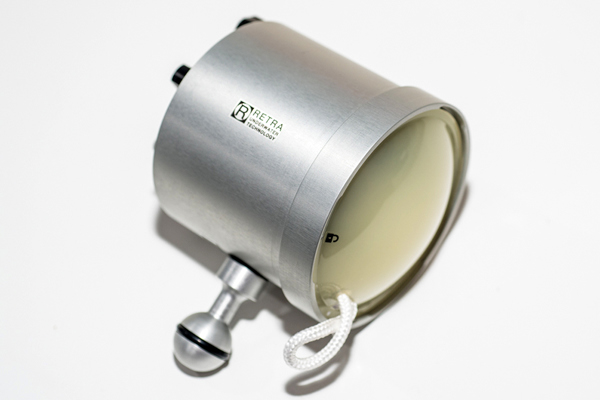
Retra are a European company best know for their optical snoots and other innovative accessories for the underwater photographer, such as the uTrigger underwater remote release. This strobe is a new venture for them.
I first heard from Retra about this strobe in mid-2015, gave feedback on an early prototype in early 2016 and took a working prototype with me this year to the Bahamas. That trip allowed me to compare it with all other major strobes (we had Seacam 150, Subtronic 270, Sea & Sea YS 250, Ikelite DS161, Inon Z240 and Sea & Sea D1 with us in Bimini) and to get some final feedback from the underwater photographers I was diving with - potential customers. Despite this involvement with the product, I am keen to state that I have not been paid for my opinions and don’t benefit in any way from future sales of this product.
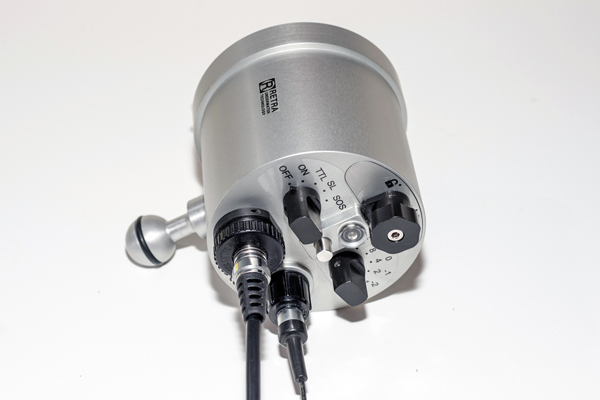
Anyone who has read Underwater Photography Masterclass will know my obsession with quality of light and the value of wide, soft illumination for underwater images. This is partly because ambient light has these characteristic underwater and partly because we work so close to our subjects that light has little distance to spread and soften. Not only does wide, soft light make subjects look better, it also makes strobe positioning and aiming slightly less critical, so makes you look like a better photographer too!
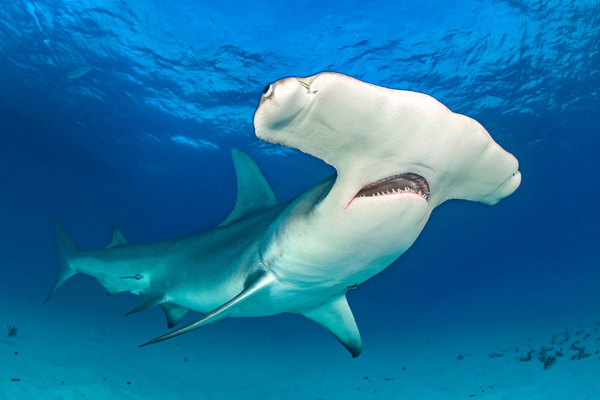
I am pleased to say that the Retra Flash has been designed by underwater photographers with this attitude first and foremost. Retra have spent a lot of effort on their reflector and diffuser to produce a wide, even illumination. The key to great light from an underwater strobe is to have as wide a spread of the brightest illumination as possible. I.E. to have almost the same amount of light reaching the subject in the centre of the beam and the edges.

Another exciting factor in the design is that the diffuser mounts to the strobe with a bayonet, which is clearly designed to make it very easy to add other accessories to modify the light from the Retra Flash for other types of lighting for different shots, including using optics as in Retra’s LSD snoots.

The Retra Flash is clearly designed as a performance upgrade for photographers currently shooting INON or Sea & Sea D1/D2 etc strobes. It is a similar size to both, although housed in a tough aluminium casing, and uses Sea & Sea electronic synch cables or fibre optics. It even takes 4 x AA batteries meaning you can even continue with the same chargers. But the Retra strobe out-guns its Japanese rivals with much wider, more even light and a bit more power (I was told that the test unit was turned down). The compact size is not only a value for travel, but also aids strobe positioning for shots where the strobes need to be tucked in close to the lens.
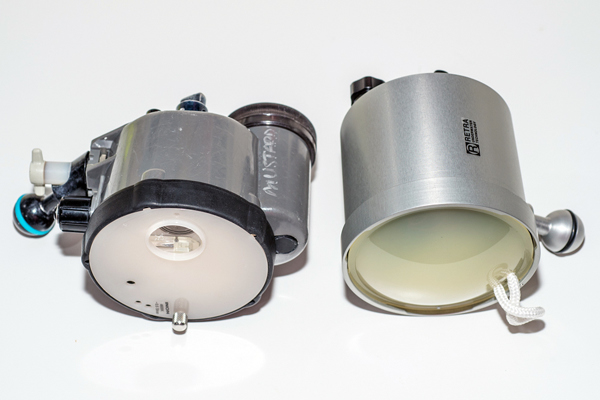
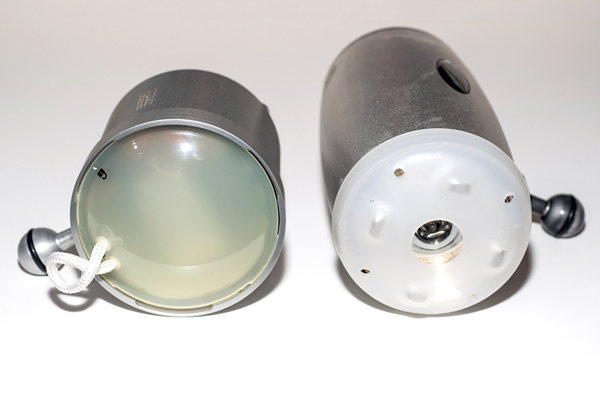
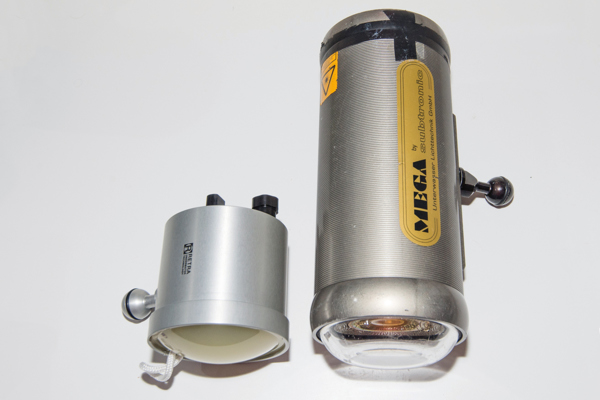
Guide Numbers are often used as a measure of strobe power. But they can be very misleading because they simply tell us how bright the centre of the beam is. I’ve already said that far more important is how wide the bright part of the beam spreads, and the wider you spread a beam the lower the Guide Number (as anyone who has ever eaten strawberry jam will attest – the more you spread it, the thinner it gets).
The easiest way to achieve a high Guide Number is to narrow the beam angle. Nikon’s land flash the SB-910 has the massive Guide Number of 53 (in metres, ISO 100), but only when the flash head is zoomed in to only cover the narrow frame of telephoto lens! When the Sea & Sea D1 was released it was marketed as having the same guide number as the much bigger, more expensive Sea & Sea YS-250 (my test below actually found it 1/3 stop greater), but it of course has far less power than its big brother (it achieves the Guide Number because it has a narrow beam). The solution many Sea & Sea D1 owners use is to add a dome diffuser, which increases the angle of coverage, but also drops the Guide Number considerably.
The Retra Flash I was testing was slightly powered down from the production models. But it still produced the same Guide Number as the Z240, YS250 and DS161 (see below), while giving a much wider spread of light than the Z240 in particular. The Sea & Sea D1 recorded a slightly higher Guide Number in my tests, but had a noticeably narrower coverage than even the INON Z240. The Seacam and Subtronic strobes, which to me seem to use the same flash tube, are a step on again in power, coverage (and price).
GUIDE NUMBERS MEASURED FROM PHOTOS (ISO 100, in Metres)
Inon Z240 with diffuser – 16
Retra Strobe with diffuser – 16
Sea & Sea YS250 with diffuser – 16
Ikelite DS161with diffuser– 16
Sea & Sea D1 with diffuser – 18
Seacam 150 with diffuser - 22
Subtronic 270 no diffuser – 25
Seacam 150 no diffuser – 25
There are a few other neat features. The strobe features a line of 4 LEDs to show battery power remaining. The aiming light is wide angle, so it can also double as a focus light. It has two powers (up to 300 lumen) and is centrally positioned for optimum performance with snoots. The sTTL mode, that I did not test, has +/-2 stop adjustability.
Retra are announcing their new strobe today and plan to start delivering it in May/June 2017. It is planned to retail at €699 Euros (excluding VAT, but including Express Worldwide DHL Shipping). There are discounts for early orders. Order before the end of Feb and it is €499, order before end of March and it is €549, and before the end of April it is €599 Euros.
The only problem I found with the strobe was that it would not fire through Nauticam’s latest housing electronics (tried it on three different NA-D5 housings) with the electronic synch cable (Seacam strobes also will not fire). All other strobes (Inon, Sea & Sea, Ikelite, Subtronic) fired with electronic cables on the Nauticam housing. And all the strobes fired without problem on other housings with standard electronic circuits.
In conclusion, it appears from these dry tests that Retra has hit their target. This strobe packs the punch and the wide spread soft light of much larger strobes, like the Ikelite DS161 and Sea & Sea YS 250, in a compact package. The fact it uses 4 x AA batteries, optical or Sea & Sea electronic synch cables, makes it a straightforward upgrade for Inon Z240 and Sea & Sea D1 users. The travel and photography friendly size may also tempt users of bigger strobes. And if that does not, the availability of accessories to modify the light will certainly appeal to photographers who care about both quantity and quality of light.
What I can’t answer in a dry review is what the strobes are like to use underwater. Will the 4 x AA batteries be enough to ensure fast recycle times at typical settings? And most critical of all, how reliable will the strobe be? On that last point, Retra seem confident and offering a two year warranty with each flash.
I’d like to thank Retra, Peter de Maagt, Theresa Guise, Martyn Guess, Martina Engels Dunmore and Nadia Aly for lending me strobes for this test.
Alex Mustard. January 2017
Retra Flash tech-spec:
● 100W/s
● 2.5s recycle time (4x eneloop pro)
● 200x full power flash (4x eneloop pro)
● 3 hour with pilot light
● 5500K color temperature (4700K with wide diffuser)
● 95º beam angle (110º with wide diffuser)
● 9 manual exposure levels
● S-TTL with +/- 2 F-stop adjustment
● Slave mode with smart pre-flash cancellation
● 300 lumen pilot light
● 4 level smart battery indicator
● S&S 5 pin, S6, N5 connector options
● Inon, Sea&Sea dual optical connector
● Length = 120mm
● Diameter = 102,5mm
● Weight = 650g (without batteries)
● Underwater weight = -50g
● -100m depth rating
● 2 year extendable Retra Warranty
For more information, please see the Retra website